Investigation of the High-Temperature and Rheological Properties for Asphalt Sealant Modified by SBS and Rubber Crumb
Abstract
:1. Introduction
2. Materials and Methods
2.1. Raw Materials
2.2. Mixture and Preparation for the CR- and SBS-Compound-Modified Asphalt Sealant
2.3. Test Methods
2.3.1. Softening Point Test
2.3.2. Temperature Sweep Test
2.3.3. Muti-Stress Creep and Recovery Test
2.3.4. Frequency Sweep Test
3. Results and Discussion
3.1. Softening Point Results and Grey Correlation Analysis
3.2. Anti-Deformation Ability
3.3. High-Temperature Performance on the Basis of MSCR
3.4. Viscoelastic Mechanical Properties and CAM Model Fitting
4. Conclusions
- (1)
- SBS and CR can improve the high-temperature performance of sealants, and the softening point of the modified sealant was able to meet the Chinese national standard (JT/T 740-2015). On the basis of grey correlation analysis, the correlation between SBS and the asphalt sealant softening point was 1.5 times that between CR and the asphalt sealant softening point.
- (2)
- The temperature sweep test revealed that both SBS and CR can increase the complex shear modulus while simultaneously decreasing the phase angle, thereby improving the performance of the modified asphalts in high-temperature environments. In all groups, asphalt sealant modified with 20% CR and 5% SBS demonstrated superior deformation resistance and high-temperature resistance. The temperature sweep test revealed that SBS and CR improved the elasticity of the modified asphalt sealants in high-temperature environments. With comprehensive consideration of the composite shear modulus and phase angle of the sealants, the viscoelastic balance of the 20% CR and 5% SBS-modified asphalt sealant was more suitable for crack repair in all groups.
- (3)
- The MSCR test showed that the composite modification procedure greatly improved the stiffness and elasticity of the modified asphalt sealants, among which the 20% CR and 7% SBS-modified asphalt sealants had the lowest and the highest , implying that it had good deformation resistance.
- (4)
- The complex main curve of shear modulus for different asphalt sealant materials at 30 °C showed that the SBS/CR-composite-modified asphalt sealant possessed greater persistent deformation resistance at elevated temperatures and lower temperature sensitivity than unmodified asphalt sealant and asphalt sealant modified with a single modifier. Additionally, the CAM model demonstrated a good ability to fit to the dynamic model curve of the modified asphalt sealant and was able to be used to reasonably evaluate the rheological properties of the sealant under load conditions that are difficult to test.
Author Contributions
Funding
Institutional Review Board Statement
Informed Consent Statement
Data Availability Statement
Acknowledgments
Conflicts of Interest
References
- Zhang, H.S.; Sheng, X.H.; Wang, S.W.; Xu, T. Effects of different modifiers on thermal stability, constituents and microstructures of asphalt-based sealant. J. Therm. Anal. Calorim. 2020, 142, 1183–1192. [Google Scholar] [CrossRef]
- Zhou, L.; Huang, W.D.; Xiao, F.P.; Lv, Q. Shear adhesion evaluation of various modified asphalt binders by an innovative testing method. Constr. Build. Mater. 2018, 183, 253–263. [Google Scholar] [CrossRef]
- Mazumder, M.; Sriraman, V.; Kim, H.H.; Lee, S. Quantifying the environmental impacts of crack sealing and filling treatment in hot mix asphalt pavement. Innov. Infrastruct. Solut. 2018, 3, 61. [Google Scholar] [CrossRef]
- Kim, H.H.; Mazumder, M.; Lee, M.; Lee, S. Laboratory Evaluation of SBS Modified Asphalt Binder Containing GTR, SIS, and PE. Adv. Civ. Eng. 2020, 2020, 8830622. [Google Scholar] [CrossRef]
- Gong, Y.; Xu, J.; Chang, R.; Yan, E. Effect of water diffusion and thermal coupling condition on SBS modified asphalts’ surface micro properties. Constr. Build. Mater. 2021, 273, 121758. [Google Scholar] [CrossRef]
- Munch, J.; Arepalli, U.M.; Barman, M. Decision Trees for Selecting Asphalt Pavement Crack Sealing Method. Transp. Res. Rec. 2020, 2675, 172–183. [Google Scholar] [CrossRef]
- Yildirim, Y. Field performance comparison of asphalt crack-filling materials: Hot pour versus cold pour. Can. J. Civ. Eng. 2007, 34, 505–512. [Google Scholar] [CrossRef]
- Cao, L.P.; Yang, C.; Dong, Z.J.; Wang, W.J.; Yin, H.M. Aging mechanism of hot-poured sealants for asphalt pavement under natural environmental exposure. Int. J. Pavement Eng. 2020, 23, 197–206. [Google Scholar] [CrossRef]
- Tan, X.Y.; Zhang, J.P.; Guo, D.; Sun, G.Q.; Zhou, Y.Y.; Zhang, W.W.; Guan, Y.S. Preparation, characterization and repeated repair ability evaluation of asphalt-based crack sealant containing microencapsulated epoxy resin and curing agent. Constr. Build. Mater. 2020, 256, 119443. [Google Scholar] [CrossRef]
- Liu, S.; Mo, L.T.; Wang, K.; Xie, Y.J.; Woldekidan, M.F. Preparation, microstructure and rheological properties of asphalt sealants for bridge expansion joints. Constr. Build. Mater. 2016, 105, 1–13. [Google Scholar] [CrossRef]
- Zhang, G.; Zhang, H.L.; Bu, X.D.; Yang, H.Z. Laboratory study on performances of bimaleimide/unsaturated polyester resin modified asphalt. Constr. Build. Mater. 2018, 179, 576–586. [Google Scholar] [CrossRef]
- Tan, Y.Q.; Guo, M.; Cao, L.P.; Zhang, L. Performance optimization of composite modified asphalt sealant based on rheological behavior. Constr. Build. Mater. 2013, 47, 799–805. [Google Scholar] [CrossRef]
- Munera, J.C.; Erick, A.O. Polymer modified bitumen: Optimization and selection. Mater. Des. 2014, 62, 91–97. [Google Scholar] [CrossRef]
- Wang, L.; Bi, F.; Zhao, P. Research progress of evaluation of rheological index properties of polymer modified asphalt. J. Shandong Jianzhu Univ. 2018, 33, 56–62. [Google Scholar] [CrossRef]
- Veropalumbo, R.; Russo, F.; Oreto, C.; Buonocore, G.G.; Verdolotti, L.; Muiambo, H.; Biancardo, S.A.; Viscione, N. Chemical, Thermal, and Rheological Performance of Asphalt Binder Containing Plastic Waste. Sustainability 2021, 13, 13887. [Google Scholar] [CrossRef]
- Veropalumbo, R.; Oreto, C.; Viscione, N.; Biancardo, S.A.; Russo, F. Environmental assessment of asphalt mastics containing plastic bottles and jet grouting waste. Environ. Impact Assess. Rev. 2022, 93, 106736. [Google Scholar] [CrossRef]
- Russo, F.; Veropalumbo, R.; Viscione, N.; Oreto, C.; Biancardo, S.A. Rheological performance of soft and rigid waste plastic-modified bitumen and mastics. Plast. Waste Sustain. Asph. Roads 2022, 4, 61–83. [Google Scholar]
- Fang, Y.; Zhan, M.S.; Wang, Y. The status of recycling of waste rubber. Mater. Des. 2000, 22, 123–127. [Google Scholar] [CrossRef]
- Nejad, F.M.; Aghajani, P.; Modarres, A.; Firoozifar, H. Investigating the properties of crumb rubber modified bitumen using classic and shrp testing methods. Constr. Build. Mater. 2012, 26, 481–489. [Google Scholar] [CrossRef]
- Kaloush, K.E. Asphalt rubber: Performance tests and pavement design issues. Constr. Build. Mater. 2014, 67, 258–264. [Google Scholar] [CrossRef]
- Zhang, B.; Chen, H.X.; Zhang, H.G.; Wu, Y.C.; Kuang, D.L.; Guo, F.J. Laboratory investigation of aging resistance for rubberized bitumen modified by using microwave activation crumb rubber and different modifiers. Materials 2020, 13, 4230. [Google Scholar] [CrossRef] [PubMed]
- Liang, M.; Xin, X.; Fan, W.Y.; Luo, H.; Wang, X.B.; Xing, B.D. Investigation of the rheological properties and storage stability of CR/SBS modified asphalt. Constr. Build. Mater. 2015, 74, 235–240. [Google Scholar] [CrossRef]
- Cong, P.L.; Xun, P.J.; Xing, M.L.; Chen, S.F. Investigation of asphalt binder containing various crumb rubbers and asphalts. Constr. Build. Mater. 2013, 40, 632–641. [Google Scholar] [CrossRef]
- Liu, H.Y.; Chen, Z.J.; Wang, W.; Wang, H.N.; Hao, P.W. Investigation of the rheological modification mechanism of crumb rubber modified asphalt (CRMA) containing tor additive. Constr. Build. Mater. 2014, 67, 225–233. [Google Scholar] [CrossRef]
- Subhy, A.; Pires, G.M.; Lo Presti, D.; Airey, G. The effects of laboratory ageing on rheological and fracture characteristics of different rubberised bitumens. Constr. Build. Mater. 2018, 180, 188–198. [Google Scholar] [CrossRef]
- Nanjegowda, V.H.; Biligiri, K.P. Recyclability of rubber in asphalt roadway systems: A review of applied research and advancement in technology. Resour. Conserv. Recycl. 2020, 155, 104655. [Google Scholar] [CrossRef]
- Meng, Y.J.; Yan, T.Y.; Muhammad, Y.; Li, J.; Qin, P.F.; Ling, L.S.; Rong, H.L.; Yang, X.L. Study on the performance and sustainability of modified waste crumb rubber and steel slag powder/SBS composite modified asphalt mastic. J. Clean. Prod. 2022, 338, 130563. [Google Scholar] [CrossRef]
- Becker, Y.M.; Muller, A.J.; Rodriguez, Y. Use of rheological compatibility criteria to study SBS modified asphalts. J. Appl. Polym. Sci. 2003, 90, 1772–1782. [Google Scholar] [CrossRef]
- Liang, M.; Xin, X.; Fan, W.Y.; Ren, S.S.; Shi, J.T.; Luo, H. Thermo-stability and aging performance of modified asphalt with crumb rubber activated by microwave and tor. Mater. Des. 2017, 127, 84–96. [Google Scholar] [CrossRef]
- Airey, G.D. Rheological properties of styrene butadiene styrene polymer modified road bitumens. Fuel 2003, 82, 1709–1719. [Google Scholar] [CrossRef]
- Behnood, A.; Olek, J. Rheological properties of asphalt binders modified with styrene-butadiene-styrene (SBS), ground tire rubber (GTR), or polyphosphoric acid (PPA). Constr. Build. Mater. 2017, 151, 464–478. [Google Scholar] [CrossRef]
- Huang, W.T.; Liu, X.; Zhang, S.W.; Zheng, Y.; Ding, Q.; Tong, B. Performance-guided design of permeable asphalt concrete with modified asphalt binder using crumb rubber and SBS modifier for sponge cities. Materials 2021, 14, 1266. [Google Scholar] [CrossRef] [PubMed]
- Ma, F.; Li, C.; Fu, Z.; Huang, Y.; Dai, J.S.; Feng, Q. Evaluation of high temperature rheological performance of polyphosphoric acid-SBS and polyphosphoric acid-crumb rubber modified asphalt. Constr. Build. Mater. 2021, 306, 124926. [Google Scholar] [CrossRef]
- Qian, C.D.; Fan, W.Y.; Yang, G.M. Influence of crumb rubber particle size and SBS structure on properties of CR/SBS composite modified asphalt. Constr. Build. Mater. 2020, 235, 117517. [Google Scholar] [CrossRef]
- Kołodziej, K.; Bichajło, L.; Siwowski, T. Effects of aging on the physical and rheological properties of trinidad lake asphalt modified bitumen. Materials 2021, 14, 2532. [Google Scholar] [CrossRef]
- Cheng, P.F.; Li, Y.M.; Zhang, Z.M. Effect of phenolic resin on the rheological, chemical, and aging properties of SBR-modified asphalt. Int. J. Pavement Res. Technol. 2021, 14, 421–427. [Google Scholar] [CrossRef]
- Ministry of Transport of the People’s Republic of China. Standard Test Methods of Bitumen and Bituminous Mixtures for Highway Engineering; Ministry of Transport of the People’s Republic of China: Beijing, China, 2011. (In Chinese)
- Yuan, D.M.; Su, B.; Liao, K.J.; Yan, F. Preparation of rubber crumb modified asphalt and its influencing factors. Hecheng Xiangjiao Gongye 2008, 30, 382–386. [Google Scholar]
- Hu, M.; Mi, H.C.; Zhang, L. Mechanism Study of Impaction of Rubber Powder Content and the Mesh on Rubber Modified Asphalt Viscosity. Pet. Asph. 2011, 2, 41–43. [Google Scholar]
- Ministry of Transport of the People’s Republic of China. Hot-Poured Sealants for Pavement; Ministry of Transport of the People’s Republic of China: Beijing, China, 2015. (In Chinese)
- Zhu, M.L.; Zhang, Q.S. Applied research on SBS modified bitumen and SMA mixture. China J. Highw. Transp. 2001, 14, 13–20. [Google Scholar]
- Liu, Y. Study on Mechanism and Performance Evaluation of SBS and Crumb Rubber Composite Modified Asphalt; Southeast University: Nanjing, China, 2018. [Google Scholar]
- Shan, C.Y.; Wei, Y.G.; Zhang, Y.J.; Li, X.H.; Nie, L.; Dong, X.L.; Liu, C. Grey correlation degree analysis on main traits of soybean varieties in Heilongjiang Province. Soybean Sci. 2009, 28, 945–948. [Google Scholar]
- Wang, K.F.; Ren, S.Y.; Qian, S.Y.; Liu, P. Grey relational analysis of benefit of surgical management for abdominal aortic aneurysm. Int. Surg. 2014, 99, 189–194. [Google Scholar] [CrossRef] [PubMed] [Green Version]
- Lin, S.M. Associating DEA with grey relational analysis for performance assessment of management competencies in logistic industry. J. Stat. Manag. Syst. 2010, 13, 1117–1130. [Google Scholar] [CrossRef]
- Hamzacebi, C.; Pekkaya, M. Determining of stock investments with grey relational analysis. Expert Syst. Appl. 2011, 38, 9186–9195. [Google Scholar] [CrossRef]
- Xu, O.M.; Xiao, F.P.; Han, S.; Amirkhanian, S.N.; Wang, Z.J. High temperature rheological properties of crumb rubber modified asphalt binders with various modifiers. Constr. Build. Mater. 2016, 112, 49–58. [Google Scholar] [CrossRef]
- Qian, C.D.; Fan, W.Y.; Liang, M.; He, Y.; Ren, S.S.; Lv, X.B.; Nan, G.Z.; Luo, H. Rheological properties, storage stability and morphology of CR/SBS composite modified asphalt by high-cured method. Constr. Build. Mater. 2018, 193, 312–322. [Google Scholar] [CrossRef]
- Xiao, B.Q.; Xiao, M.L.; Ding, B.W. Research on Rubber/SBS modified asphalt by MSCR test. Adv. Mater. Res. 2012, 557–559, 1066–1069. [Google Scholar] [CrossRef]
- Ren, S.S.; Liu, X.Y.; Li, M.L.; Fan, W.Y.; Xu, J.; Erkens, S. Experimental characterization of viscoelastic behaviors, microstructure and thermal stability of CR/SBS modified asphalt with TOR. Constr. Build. Mater. 2020, 261, 120524. [Google Scholar] [CrossRef]
- Li, C.M.; Ning, F.B.; Li, Y.Y. Effect of carbon black on the dynamic moduli of asphalt mixtures and its master curves. Front. Struct. Civ. Eng. 2012, 13, 918–925. [Google Scholar] [CrossRef]
- Tan, G.J.; Wang, W.S.; Cheng, Y.C.; Wang, Y.; Zhu, Z.Q. Master curve establishment and complex modulus evaluation of sbs-modified asphalt mixture reinforced with basalt fiber based on generalized sigmoidal model. Polymers 2020, 12, 1586. [Google Scholar] [CrossRef]
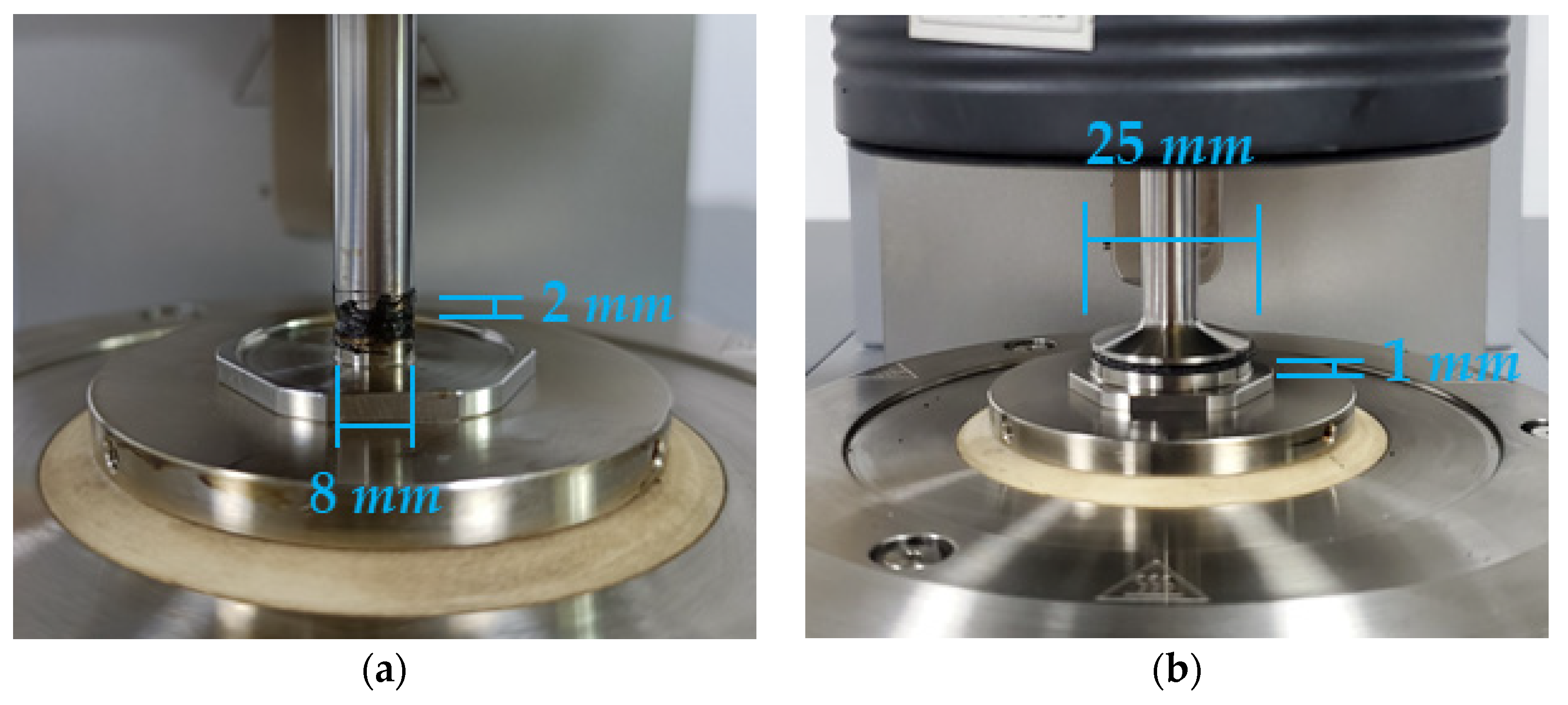
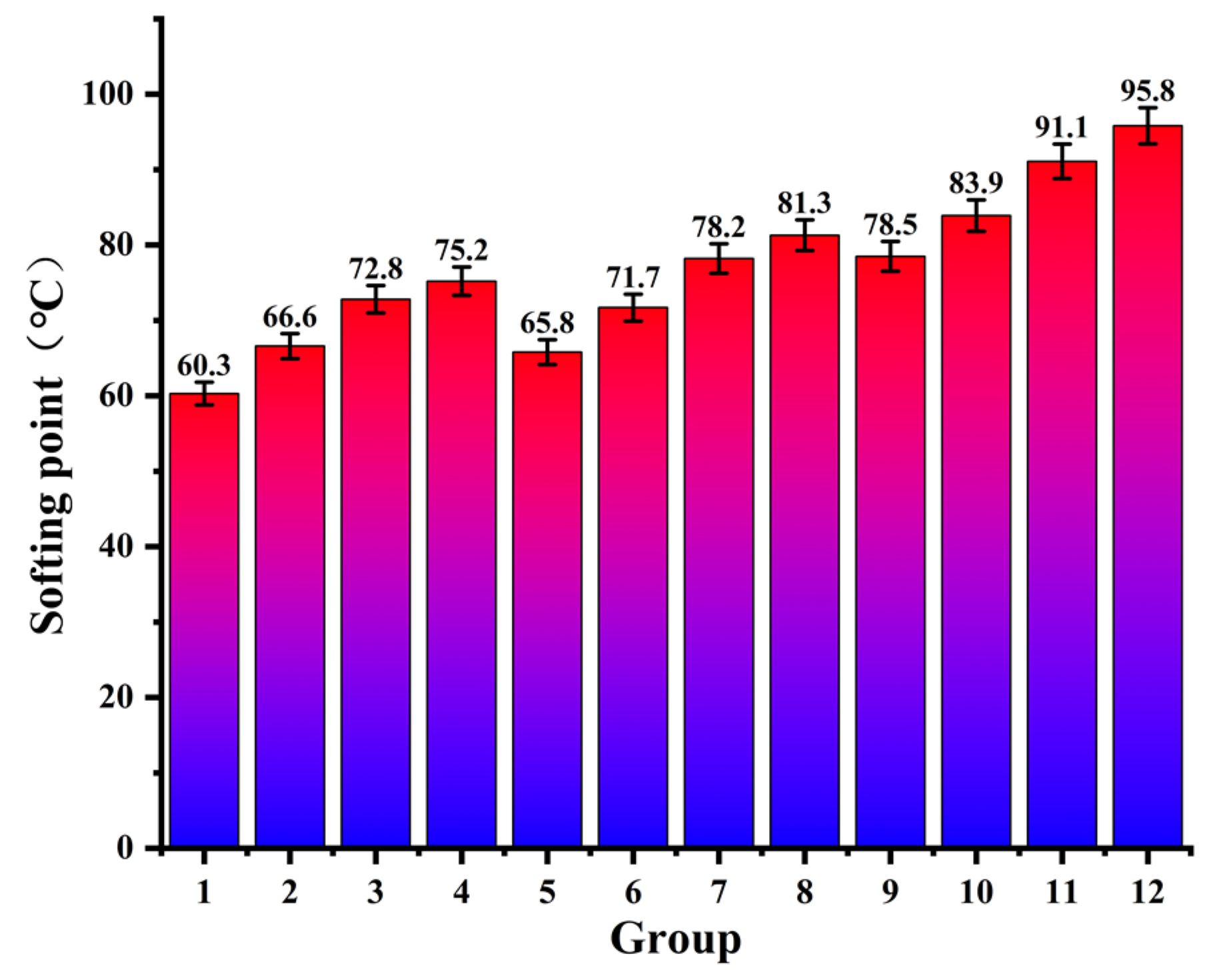
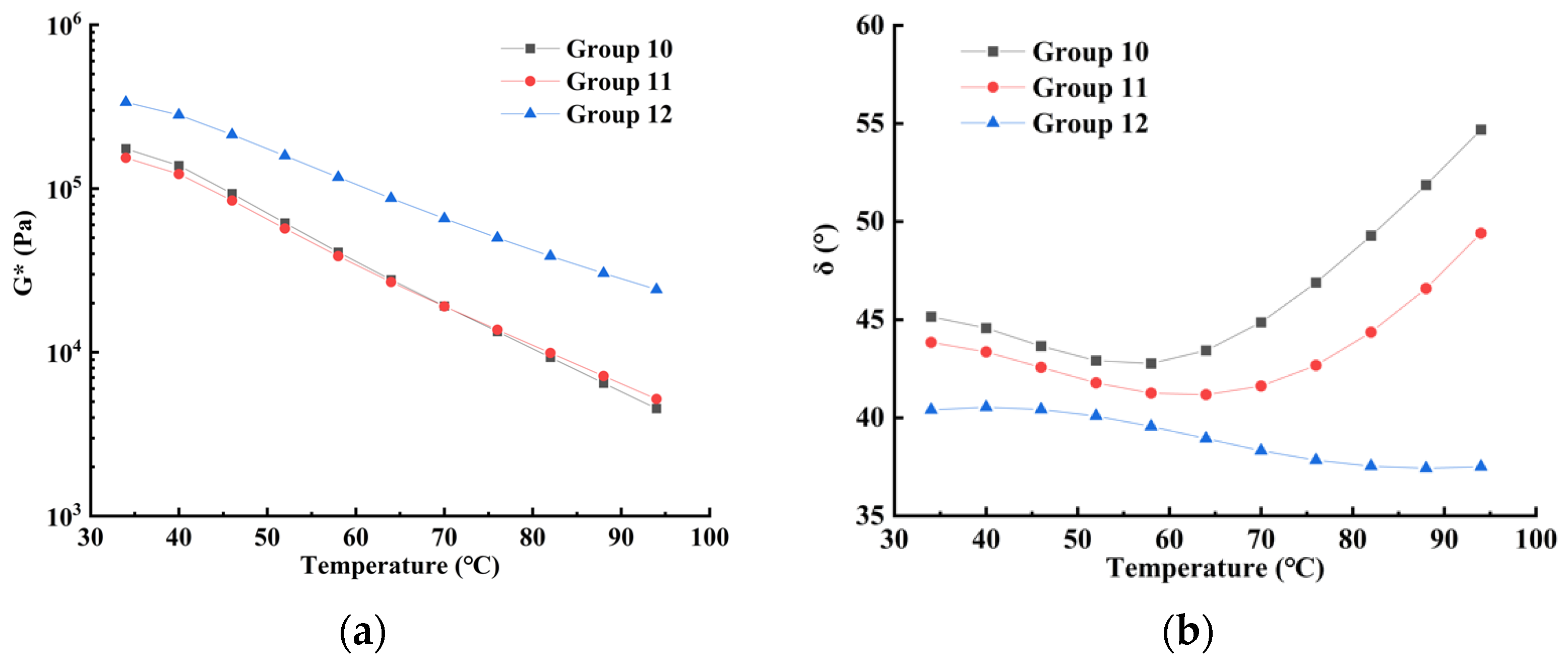
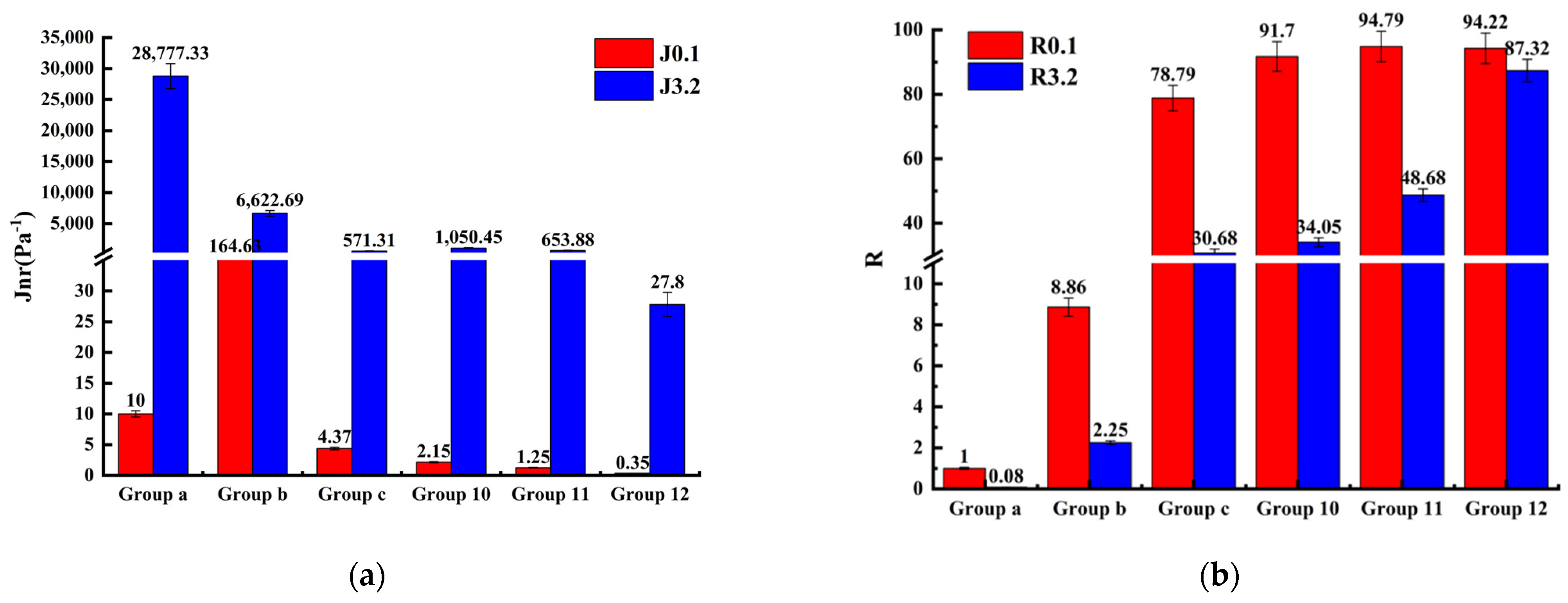

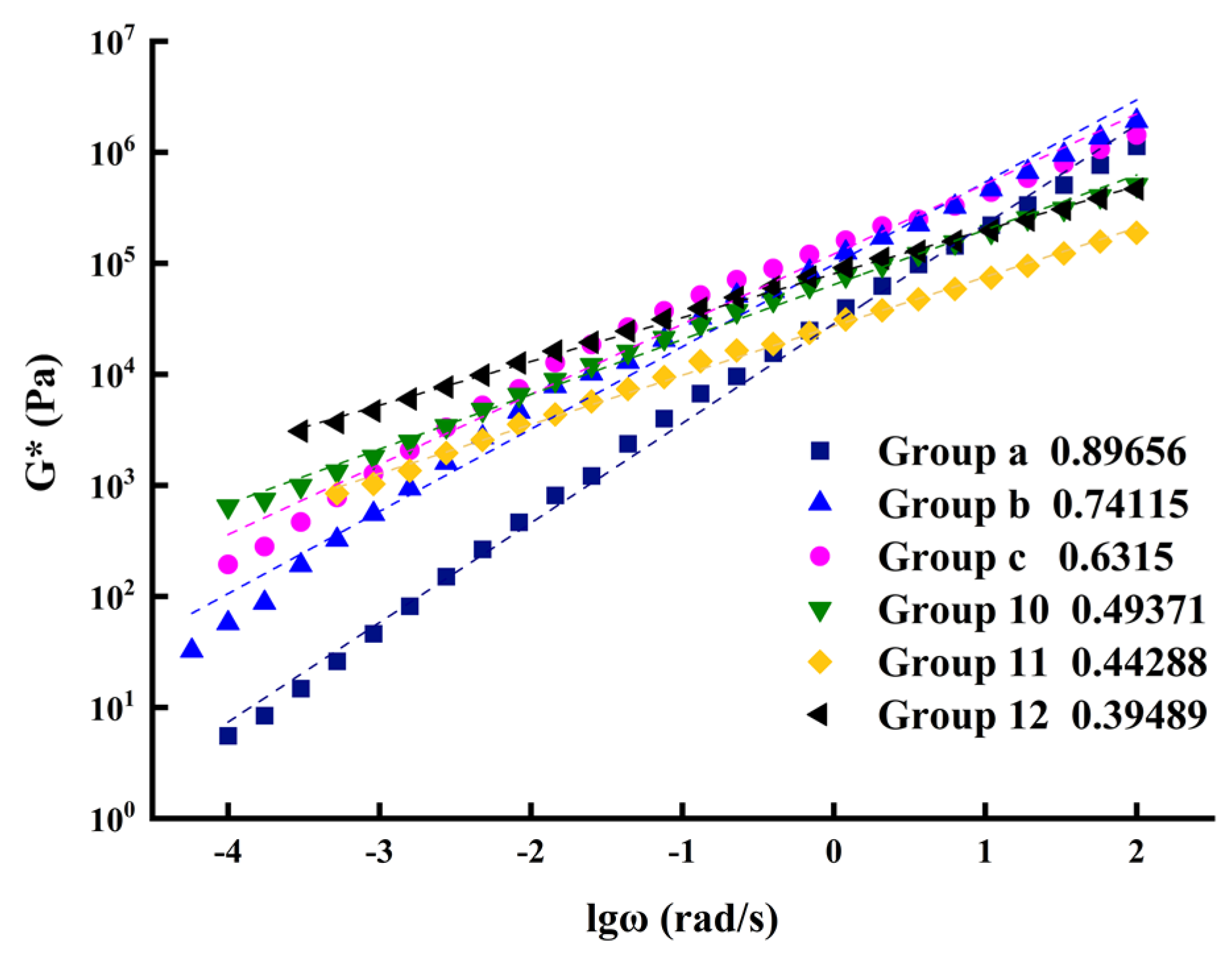
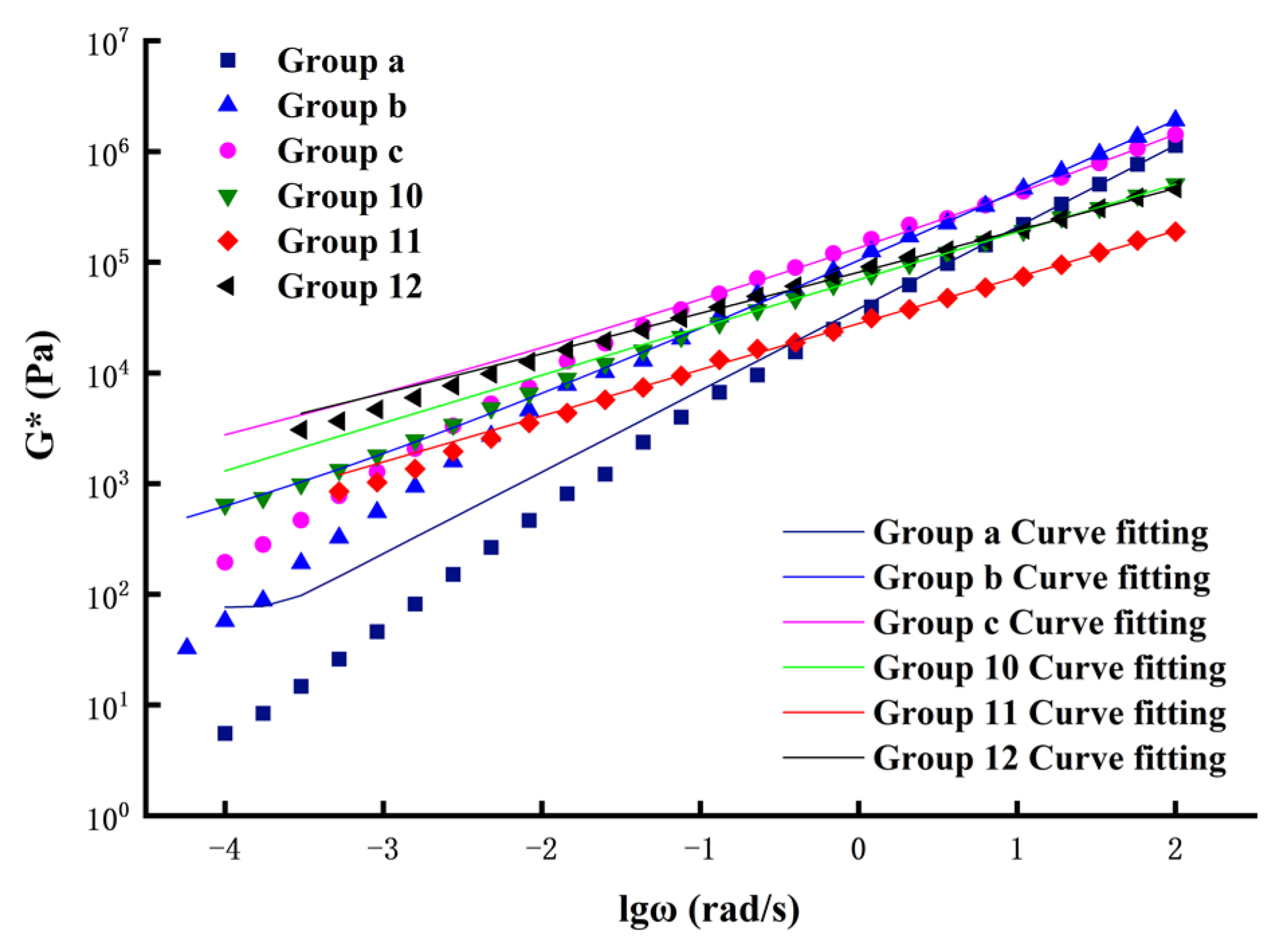
| Index | Standard Value | Measured Results |
|---|---|---|
| Softening Point (Global Method) | ≥45 (°C) | 46.0 (°C) |
| Penetration (25 °C, 100 g, s) | 80~100 (0.01 mm) | 84 (0.01 mm) |
| Ductility (15 °C) | ≥100 (cm) | >100 (cm) |
| TFOT (Thin Film Oven Test) Residue | ||
| Quality Change | ±0.8 (%) | −0.112 (%) |
| Residual Penetration Ratio | ≥57 (%) | 62.4 (%) |
| Residual Ductility (10 °C) | ≥8 (cm) | 11.9 (cm) |
| Index | Standard Value | Measured Value |
|---|---|---|
| Sieving rate | ≥45% | 91% |
| Ash content | ≤10% | 4.5% |
| Moisture content | ˂1% | 0.6% |
| Fiber content | ˂1% | 0.5% |
| Rubber content | ≥48% | 51% |
| Burn Participation | ˂38% | 37.5% |
| Group | CR Contents (%) | SBS Contents (%) |
|---|---|---|
| 1 | 10 | 1 |
| 2 | 10 | 3 |
| 3 | 10 | 5 |
| 4 | 10 | 7 |
| 5 | 15 | 1 |
| 6 | 15 | 3 |
| 7 | 15 | 5 |
| 8 | 15 | 7 |
| 9 | 20 | 1 |
| 10 | 20 | 3 |
| 11 | 20 | 5 |
| 12 | 20 | 7 |
| Index | Sample | |||||||||||
|---|---|---|---|---|---|---|---|---|---|---|---|---|
| 1 | 2 | 3 | 4 | 5 | 6 | 7 | 8 | 9 | 10 | 11 | 12 | |
| CR | 10 | 10 | 10 | 10 | 15 | 15 | 15 | 15 | 20 | 20 | 20 | 20 |
| SBS | 1 | 3 | 5 | 7 | 1 | 3 | 5 | 7 | 1 | 3 | 5 | 7 |
| Difference sequence | 35.5 | 29.2 | 23 | 20.6 | 30 | 24.1 | 17.6 | 14.5 | 17.3 | 11.9 | 4.7 | 0 |
| Factor | k | Grey Relation Coefficient | |||||||||||
|---|---|---|---|---|---|---|---|---|---|---|---|---|---|
| 1 | 2 | 3 | 4 | 5 | 6 | 7 | 8 | 9 | 10 | 11 | 12 | ||
| R1 | 0.64 | 0.64 | 0.64 | 0.64 | 0.54 | 0.54 | 0.54 | 0.54 | 0.47 | 0.47 | 0.47 | 0.47 | 0.55 |
| R2 | 0.94 | 0.85 | 0.78 | 0.72 | 0.94 | 0.85 | 0.78 | 0.72 | 0.94 | 0.85 | 0.78 | 0.72 | 0.82 |
| Asphalt | Parameter | Shift Factor | R2 | |||||
|---|---|---|---|---|---|---|---|---|
| C1 | C2 | 30 | 40 | 50 | 60 | 70 | ||
| Group a | 6.349 | 46.509 | 0 | −1.217 | −1.844 | −2.433 | −2.990 | 0.9952 |
| Group b | 10.508 | 86.7 | 0 | −1.045 | −1.988 | −2.732 | −3.295 | 0.9993 |
| Group c | 9.329 | 87.64 | 0 | −1.078 | −1.642 | −2.345 | −2.964 | 0.9933 |
| Group 10 | 10.109 | 100.127 | 0 | −0.905 | −1.718 | −2.295 | −2.899 | 0.9993 |
| Group 11 | 6.188 | 42.558 | 0 | −1.117 | −2.002 | −2.633 | −2.944 | 0.9971 |
| Group 12 | 17.545 | 238.033 | 0 | −0.710 | −1.301 | −2.046 | −2.491 | 0.9962 |
Publisher’s Note: MDPI stays neutral with regard to jurisdictional claims in published maps and institutional affiliations. |
© 2022 by the authors. Licensee MDPI, Basel, Switzerland. This article is an open access article distributed under the terms and conditions of the Creative Commons Attribution (CC BY) license (https://creativecommons.org/licenses/by/4.0/).
Share and Cite
Gong, Y.; Wu, S.; Zhang, Y.; Pang, Y.; Ma, Y. Investigation of the High-Temperature and Rheological Properties for Asphalt Sealant Modified by SBS and Rubber Crumb. Polymers 2022, 14, 2558. https://doi.org/10.3390/polym14132558
Gong Y, Wu S, Zhang Y, Pang Y, Ma Y. Investigation of the High-Temperature and Rheological Properties for Asphalt Sealant Modified by SBS and Rubber Crumb. Polymers. 2022; 14(13):2558. https://doi.org/10.3390/polym14132558
Chicago/Turabian StyleGong, Yafeng, Shuzheng Wu, Yuwei Zhang, Yunze Pang, and Yulin Ma. 2022. "Investigation of the High-Temperature and Rheological Properties for Asphalt Sealant Modified by SBS and Rubber Crumb" Polymers 14, no. 13: 2558. https://doi.org/10.3390/polym14132558
APA StyleGong, Y., Wu, S., Zhang, Y., Pang, Y., & Ma, Y. (2022). Investigation of the High-Temperature and Rheological Properties for Asphalt Sealant Modified by SBS and Rubber Crumb. Polymers, 14(13), 2558. https://doi.org/10.3390/polym14132558






